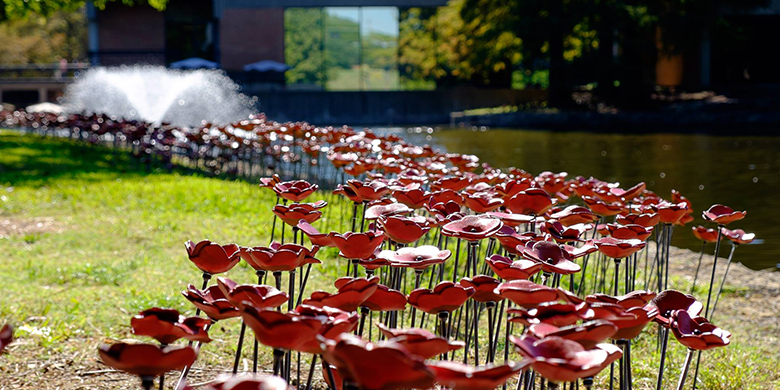Last updated on October 8, 2019
World War I… the forgotten war… the war commemorated for years with poppies… the war in which 5,171 Texas veterans died.
Now, 5,171 ceramic poppies on the campus of Richland College are stark reminders of those veterans from the Lone Star State who died during what history professor Clive Siegle now calls “the almost forgotten war.” The installation is the only one of its kind in the United States.
Siegle, whose great uncle fought in WWI, collaborated with Jennifer Rose in visual arts; together, they conceptualized and created the project, which became a three-day program to resurrect the poppy as a symbol of remembrance for that war. Siegle handled the historical aspects and research; Rose oversaw the design and creation of the poppies in her ceramics lab. Additionally, dance faculty member Gina Sawyer choreographed a special piece, “The War,” for the remembrance event.
“This project is a chance for us to resurrect something that is uniquely American,” said Siegle. “The idea to use the poppy as a symbol of remembrance for Americans who died in World War I originated with Moina Belle Michael, a teacher and YMCA volunteer from Georgia. After reading the poem ‘In Flanders Field’ by Lt. Col. John McCrae, Moina wrote her own poem and became known as ‘The Founder of the Poppy Memorial’ (so noted on a 1948 commemorative U.S. postage stamp) as she campaigned to have that flower accepted as a symbol for U.S. veterans who died in that first great world war.”
“The Blood of Heroes Never Dies,” which is the theme for what’s become known fondly as Richland’s “Poppy Project,” comes from Michael’s poem “We Shall Keep the Faith.” Last year, Great Britain created its own ceramic poppy tribute for the British Commonwealth’s veterans from WWI.
The poppies were hand-formed, baked, glazed and assembled individually by approximately 500 volunteers – students, faculty, staff and community members – over a two-month period. “Every poppy is as individual as each soldier who served during the war,” explained Rose.
The deep red poppies were installed in late October, with the exception of one lone white flower representing a nurse from Texas who was the only woman from the state to die serving in that war, plus the final red poppy that will be installed the morning of Veterans Day.
Why undertake such a huge project?
Siegle, a Vietnam-era veteran, explained: “Many of my students hardly know what that war (WWI) was about and that we had a huge stake in it. It was a horrific war, and the U.S. entered late. However, even though we entered late, it still took its toll; we went through all of the worst aspects of combat during World War I like everyone else.”
He added, “This project, for me, started with the centenary of World War I. I’m a history teacher. The legacy of the poppy is part of history. The fact that World War I is fading from our collective memory even more quickly than World War II also prompted me to get involved. We are losing contact with memorial legacies like the poppy, which are slipping away, and we don’t have a lot of symbols of remembrance for that war. For example… The Vietnam Memorial is our current and probably the most prominent war symbol, and it’s different from how we remember World War I. The poppy has a rich history, and we need to bring it back.”
The origin of the memorial poppy and its connection to Veterans Day – and initially with Armistice Day/Memorial Day – dates from one of the most famous poems to come out of that most infamous of wars, World War I, said Siegle. From the start of the war in August 1914, the use of sophisticated weaponry on an industrial scale produced staggering casualty rates which, by the end of hostilities, exceeded 37 million.
By 1915, the appalling casualties and ferocity of the war moved McCrae to pen the war’s most famous poem, “In Flanders Fields.” The poppy figured into the poem, said Siegle, because it is a flower native to Flanders that thrives in disturbed soil—something that the millions of battlefield shell craters and burial mounds covering the Flanders landscape provided in abundance. McCrae did not survive the war, and he was buried in a grave likely covered by those same Flanders poppies he cited in his poem.
During the 1920s, the American Legion and Veterans of Foreign Wars began selling cloth or paper “Buddy Poppies” to raise funds for needy veterans. These poppies are still sold to benefit U.S. veterans but, by the 1960s, the practice began to disappear. Last year, Siegle handed out paper poppies in his history classes and explained to his students what they were. Most had never seen or heard about them and what they symbolized.
The project has become the focal point for this year’s Richland College Arts Fest, which remembers Texas heroes. The event spans three days of exhibits and performances – from dramatic readings to concerts and lectures to the poppy installation commemorating Texas veterans who died during that century-old war.
The poppies will remain “planted” on campus until the end of November; each will be sold for $10. Proceeds will be donated to “Puppies Behind Bars,” a nonprofit organization that engages incarcerated individuals to train assistance dogs for veterans who have mobility disabilities as well as cognitive disabilities such as mild traumatic brain injury and post-traumatic stress.
A pre-World War II Stearman bi-plane will fly over the campus during the Veterans Day program; the flyover has been made possible by the Commemorative Air Force which is based at Dallas Executive Airport. An indoor exhibit in Fannin Hall (near the lakeshore poppy installation) commemorates a number of Texas WWI veterans through photographs and pictures of ID cards issued to several veterans killed in action.
More Information About DCCCD
- Visit the Richland College website.
- Find the maps and locations of our various campuses.
